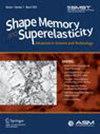点缺陷对niti基形状记忆合金B19″相单斜角的影响
IF 2.4
Q3 MATERIALS SCIENCE, MULTIDISCIPLINARY
引用次数: 0
摘要
摘要本文研究了多种点状缺陷对NiTi中B19″马氏体单斜角的影响,包括Ni和Ti空位、晶格中Ni - Ti反位、第三元素取代以及B2化学计量学中Ni和Ti的富集。通过密度泛函理论计算,研究了它们对单斜相B19″的影响,作为实验观察到的B19′相的代表。发现空位和Ni - Ti反位降低了B19的单斜角″,而Ni和Ti的第三元素取代可能在两个方向上影响单斜角,这取决于它所取代的第三元素和宿主元素。富集Ni或Ti含量使其偏离B2化学计量,减小了单斜角度。B19″相单斜角的变化意味着与转变相关的特征菌株的变化。因此,这些发现可能为实验观察到的NiTi形状记忆合金的可恢复转变应变的变化提供一个新的解释角度。本文章由计算机程序翻译,如有差异,请以英文原文为准。
Effects of Point Defects on the Monoclinic Angle of the B19″ Phase in NiTi-Based Shape Memory Alloys
Abstract This study investigated the effects of a variety of point defects on the monoclinic angle of the B19″ martensite in NiTi, including Ni and Ti vacancies, Ni–Ti anti-sites in the lattice, third element substitution, and Ni and Ti enrichments in the B2 stoichiometry. Their effects were studied by density functional theory calculations on the monoclinic B19″ phase as a proxy for the experimentally observed B19′ phase. It was found that vacancies and Ni–Ti anti-sites reduce the monoclinic angle of B19″, whereas third element substitution of Ni and Ti may affect the monoclinic angle in both directions depending on the third element and the host element it replaces. Enriching Ni or Ti content to deviate from the B2 stoichiometry decreases the monoclinic angle. A change in the monoclinic angle of the B19″ phase implies variation in the characteristic strains associated with the transformation. Thus, these findings may provide a new angle on possible interpretations of the variations of recoverable transformation strains experimentally observed of NiTi shape memory alloys.
求助全文
通过发布文献求助,成功后即可免费获取论文全文。
去求助
来源期刊

Shape Memory and Superelasticity
MATERIALS SCIENCE, MULTIDISCIPLINARY-
CiteScore
4.20
自引率
13.60%
发文量
39
期刊介绍:
The Shape Memory and Superelasticity journal invites original peer-reviewed papers that focus on shape memory materials research with contributions from materials science, materials engineering, experimental and theoretical mechanics, mathematics and physics. Of particular interest is to understand the response of these materials to external stimuli such as force, displacement, temperature, magnetic fields, irradiation, corrosive media and so on in pursuit of uncovering new phenomenon, new materials and new applications as follows: (i) the journal papers will examine these materials utilizing the principles of continuum mechanics, micromechanics, microstructuraly informed constitutive modeling, atomistic models, mathematics of microstructures and other methodologies. (ii) the development and use of advanced experimental techniques to expose and understand the shape memory response including thermal and mechanical cycling, application of magnetic and other external fields, (iii) the exploration and further understanding of shape memory materials due to fatigue, fracture and environmental factors are of significant interest, (iv) novel applications of the materials will be explored in all areas including bio-medical devices, actuators, thin films, robotics, mechanical and aerospace engineering components, civil engineering structures, and micro-electromechanical systems (MEMS). Specifically, the journal will include the following topics: (1) Behavior of all classes of shape memory materials including metals, non-metals (such as shape memory ceramics, shape memory polymers) and shape memory composites, (2) Stress-strain response in thermo-mechanical loadings (experimental observations and modeling), (3) Life prediction methodologies (different approaches including fracture mechanics, role of grain boundaries, the role of slip and twinning on shape memory behavior, crack nucleation modeling), (4) Thermodynamics of the transformation, the fundamentals of superelasticity and related areas such as twinning, detwinning, residual martensites, (5) Solutions of shape memory problems in industry (including biomedical, electronic, MEMS, microdevice and microactuator applications and applications in aero-, civil-, mechanical, electrical and other engineering disciplines), (6) Critical experiments that shed insight into shape memory behavior including digital image correlation, diffraction methodologies (including those using high energy sources), in-situ microscopy, infra red imaging techniques, and conventional and nano mechanical testing methods, (7) Novel experimental techniques for shape memory response (ranging from specimens of micron size, wires, laboratory specimens, rings, bent beams, complex shapes to components, and complex loading conditions), (8) Single Crystals and polycrystals of shape memory metals highlighting the role of texture and orientation effects on superelasticity and recoverable strain levels, and the role of different processing methods on the SMA response, (9) Shape memory response under coupled mechanical-magnetic fields, irradiation effects, magnetic shape memory and thermo-caloric effects, high temperature applications, (10) Alloy design (with cognizance of the chemical composition of underlying phases and crystallography) to tailor the properties to achieve shape memory materials with improved functionality in applications, (11) Surface engineering, corrosion and interaction of SMAs with fluids, behavior of shape memory thin films, and shape memory at nanoscale, (12) Application of atomistic methods (density functional theory and molecular dynamics) to gain insight into properties of such materials and enlighten shape memory alloy design with these materials, (13) Production and processing of shape memory alloys, including shape memory metals, shape memory polymers, shape memory ceramics, thin films, nanosize objects and specimens, and hybrids. Niche- The Journal of Shape Memory and Superelasticity supplies the readers with knowledge focused on shape memory materials and highlighting contributions that could influence other disciplinary fields in engineering, sciences, and medicine. The journal brings together the latest innovations in this ever-expanding field. The journal provides a forum for researchers, scientists and engineers of varied disciplines to access information about shape memory materials. The journal is aimed at disclosing the most pertinent needs in this area and providing a systematic approach to address these needs with experiments, theory and simulation. Articles are authored to describe results from original research and provide technical information that can be appreciated by readers in the subdisciplines while providing significant results that may foster research in applications and related areas. Therefore, the information provided can be utilized in many different disciplines, including medical device design, energy harvesting, structural damping and so on.
 求助内容:
求助内容: 应助结果提醒方式:
应助结果提醒方式:


